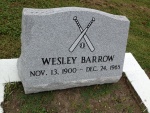New Orleans Negro Leagues legend Wesley Barrow to receive new grave marker
On Saturday, April 25, 2015, at 2 p.m., community volunteers, city of Gretna officials and former local Negro Leagues baseball players will gather at New Hope Baptist Church Cemetery in Gretna, Louisiana, to dedicate a new grave marker for Wesley Barrow, a New Orleans African-American baseball legend who influenced hundreds, if not thousands, of young men and players locally and nationally.
 The SABR Schott-Pelican Chapter will also hold its quarterly spring meeting on Saturday, April 25 from 10 a.m.-12 p.m. at the Holiday Inn New Orleans West Bank Tower (275 Whitney Avenue, Room 210 upstairs) in Gretna. All baseball fans are welcome to attend the SABR meeting and the dedication ceremony afterward.
The SABR Schott-Pelican Chapter will also hold its quarterly spring meeting on Saturday, April 25 from 10 a.m.-12 p.m. at the Holiday Inn New Orleans West Bank Tower (275 Whitney Avenue, Room 210 upstairs) in Gretna. All baseball fans are welcome to attend the SABR meeting and the dedication ceremony afterward.
Barrow enjoyed a 40-plus-year career in America’s pastime as a player and manager for numerous local African-American sandlot, semipro and professional teams during the era of baseball segregation and beyond.
His talent for discovering and development the talent and character of young players earned him the nickname “the Skipper” and stints as the pilot of teams across the country as well, including the Baltimore Black Sox and Portland Rosebuds.
However, despite his massive influence on the local and national black baseball scene, when Barrow died suddenly on Christmas Eve 1965, he was buried in an unmarked grave in New Hope Baptist Church Cemetery in Gretna.
His burial spot remained anonymous until this spring, when Gretna City Councilman Milton Crosby, who played for Barrow on the New Orleans Black Pelicans, and SABR member Ryan Whirty, a Negro Leagues journalist and researcher, led an effort to raise money to purchase a marker for Barrow’s grave.
Earlier this month, the burial stone was erected on Barrow’s grave, a process that also included a fresh coat of white paint on the cement border around Barrow’s final resting place.
Crosby said Barrow’s influence in his life was, quite simply, massive.
“Wesley was one of the reasons I got a scholarship to Grambling,” the city councilman said. “He taught me all I knew about baseball, and he was a fun guy, too.”
One of the primary donors in the purchase of the headstone was Rodney Page, the son of legendary local sports promoter, owner and entrepreneur Allen Page, who was a close friend of Barrow’s. Rodney Page, who also played for Barrow as a youth, will travel from his home in Austin, Texas, to attend the marker dedication ceremony April 25.
“The ceremony is an occasion to honor and celebrate the life and memory of Wesley Barrow, a New Orleans-area Negro League baseball legend,” Page said. “In addition, it offers a sacred moment to ensure him dignity in death. May time never diminish his worth, significance or memory, and may his soul and spirit always sense and feel our respect and remembrance.”
The New Orleans community has begun to recognize Barrow’s importance to local baseball history, especially with the rehabilitation of Wesley Barrow Stadium in Pontchartrain Park, which is the home of Major League Baseball’s newest Urban Youth Academy.
The dedication ceremony will feature a prayer by New Hope Baptist Church pastor Rev. Warren E. Johnson, as well as remarks by Crosby, Page and other men who played for Wesley Barrow. Several former players will be in attendance, as will members of SABR’s local Schott-Pelican Chapter.
New Hope Baptist Church Cemetery is located in the city of Gretna at the intersection of the Westbank Expressway and Lafayette Street across from McDonald’s.
For more information on Wesley Barrow and the April 25 dedication ceremony, or to arrange interviews with Crosby, Page and other attendees of the event, contact Ryan Whirty at rwhirty218@yahoo.com or (315) 690-6551.
- Donate to SABR’s Negro Leagues Baseball Grave Marker Project: Click here to make a tax-deductible contribution; your support will be used to help locate the gravesites of former ballplayers from the Negro Leagues and adorn them with proper headstones.
Originally published: April 15, 2015. Last Updated: April 15, 2015.


